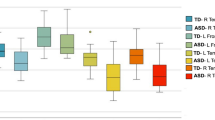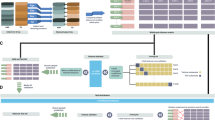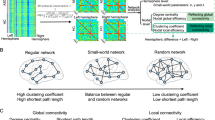Abstract
Brain imaging studies contribute to the neurobiological understanding of Autism Spectrum Conditions (ASC). Herein, we tested the prediction that distributed neurodevelopmental abnormalities in brain development impact on the homogeneity of brain tissue measured using texture analysis (TA; a morphological method for surface pattern characterization). TA was applied to structural magnetic resonance brain scans of 54 adult participants (24 with Asperger syndrome (AS) and 30 controls). Measures of mean gray-level intensity, entropy and uniformity were extracted from gray matter images at fine, medium and coarse textures. Comparisons between AS and controls identified higher entropy and lower uniformity across textures in the AS group. Data reduction of texture parameters revealed three orthogonal principal components. These were used as regressors-of-interest in a voxel-based morphometry analysis that explored the relationship between surface texture variations and regional gray matter volume. Across the AS but not control group, measures of entropy and uniformity were related to the volume of the caudate nuclei, whereas mean gray-level was related to the size of the cerebellar vermis. Similar to neuropathological studies, our study provides evidence for distributed abnormalities in the structural integrity of gray matter in adults with ASC, in particular within corticostriatal and corticocerebellar networks. Additionally, this in-vivo technique may be more sensitive to fine microstructural organization than other more traditional magnetic resonance approaches and serves as a future testable biomarker in AS and other neurodevelopmental disorders.
This is a preview of subscription content, access via your institution
Access options
Subscribe to this journal
Receive 6 print issues and online access
$259.00 per year
only $43.17 per issue
Buy this article
- Purchase on Springer Link
- Instant access to full article PDF
Prices may be subject to local taxes which are calculated during checkout




Similar content being viewed by others
References
American Psychiatric Association. Diagnostic and Statistical Manual of Mental Disorders, Revised 4th edn. American Psychiatric Association: Washington, DC, 2000.
Geschwind DH . Autism: many genes, common pathways? Cell 2008; 135: 391–395.
Abrahams BS, Geschwind DH . Connecting genes to brain in the autism spectrum disorders. Arch Neurol 2010; 67: 395–399.
Voineagu I, Wang X, Johnston P, Lowe JK, Tian Y, Horvath S et al. Transcriptomic analysis of autistic brain reveals convergent molecular pathology. Nature 2011; 474: 380–384.
Newschaffer CJ, Croen LA, Daniels J, Giarelli E, Grether JK, Levy SE et al. The epidemiology of autism spectrum disorders. Annu Rev Publ Health 2007; 28: 235–258.
Geschwind DH, Levitt P . Autism spectrum disorders: developmental disconnection syndromes. Curr Opin Neurobiol 2007; 17: 103–111.
Woodbury-Smith MR, Volkmar FR . Asperger syndrome. Eur Child Adolesc Psychiatry 2009; 18: 2–11.
Stanfield AC, McIntosh AM, Spencer MD, Philip R, Gaur S, Lawrie SM . Towards a neuroanatomy of autism: a systematic review and meta-analysis of structural magnetic resonance imaging studies. Eur Psychiatry 2008; 23: 289–299.
Via E, Radua J, Cardoner N, Happe F, Mataix-Cols D . Meta-analysis of gray matter abnormalities in autism spectrum disorder: should Asperger disorder be subsumed under a broader umbrella of autistic spectrum disorder? Arch Gen Psychiatry 2011; 68: 409–418.
Schumann CM, Barnes CC, Lord C, Courchesne E . Amygdala enlargement in toddlers with autism related to severity of social and communication impairments. Biol Psychiatry 2009; 66: 942–949.
Verhoeven JS, De Cock P, Lagae L, Sunaert S . Neuroimaging of autism. Neuroradiology 2010; 52: 3–14.
Minshew NJ, Keller TA . The nature of brain dysfunction in autism: functional brain imaging studies. Curr Opin Neurol 2010; 23: 124–130.
Amaral DG, Schumann CM, Nordahl CW . Neuroanatomy of autism. Trends Neurosci 2008; 31: 137–145.
Palmen SJ, van Engeland H, Hof PR, Schmitz C . Neuropathological findings in autism. Brain 2004; 127 (Part 12): 2572–2583.
Casanova MF, Buxhoeveden DP, Switala AE, Roy E . Neuronal density and architecture (Gray Level Index) in the brains of autistic patients. J Child Neurol 2002; 17: 515–521.
Mangin JF, Jouvent E, Cachia A . In-vivo measurement of cortical morphology: means and meanings. Curr Opin Neurol 2010; 23: 359–367.
Wallace GL, Dankner N, Kenworthy L, Giedd JN, Martin A . Age-related temporal and parietal cortical thinning in autism spectrum disorders. Brain 2010; 133 (Part 12): 3745–3754.
Nordahl CW, Dierker D, Mostafavi I, Schumann CM, Rivera SM, Amaral DG et al. Cortical folding abnormalities in autism revealed by surface-based morphometry. J Neurosci 2007; 27: 11725–11735.
Kassner A, Thornhill RE . Texture analysis: a review of neurologic MR imaging applications. AJNR Am J Neuroradiol 2010; 31: 809–816.
Ganeshan B, Miles KA, Young RC, Chatwin CR, Gurling HM, Critchley HD . Three-dimensional textural analysis of brain images reveals distributed grey-matter abnormalities in schizophrenia. Eur Radiol 2009; 20: 941–948.
Kovalev VA, Petrou M, Suckling J . Detection of structural differences between the brains of schizophrenic patients and controls. Psychiatry Res 2003; 124: 177–189.
Ashburner JT, Friston KJ . Voxel-based morphometry. In: Friston KJ, Ashburner JT, Kiebel SJ, Nichols TE, Penny WD (eds). Statistical Parametric Mapping. The Analysis of Functional Brain Images, 2007, p 92. Academic Press, Elsevier; http://books.elsevier.com.
Leekam SR, Libby SJ, Wing L, Gould J, Taylor C . The Diagnostic Interview for Social and Communication Disorders: algorithms for ICD-10 childhood autism and Wing and Gould autistic spectrum disorder. J Child Psychol Psychiatry 2002; 43: 327–342.
Lugnegard T, Hallerback MU, Gillberg C . Psychiatric comorbidity in young adults with a clinical diagnosis of Asperger syndrome. Res Dev Disabil 2011; 32: 1910–1917.
Hardeveld F, Spijker J, De Graaf R, Nolen WA, Beekman AT . Prevalence and predictors of recurrence of major depressive disorder in the adult population. Acta psychiatrica Scandinavica 2009; 122: 184–191.
Nelson HE, O’Connell A . Dementia: the estimation of premorbid intelligence levels using the New Adult Reading Test. Cortex 1978; 14: 234–244.
Ashburner J, Friston KJ . Computing average shaped tissue probability templates. NeuroImage 2009; 45: 333–341.
Bergouignan L, Chupin M, Czechowska Y, Kinkingnehun S, Lemogne C, Le Bastard G et al. Can voxel based morphometry, manual segmentation and automated segmentation equally detect hippocampal volume differences in acute depression? NeuroImage 2009; 45: 29–37.
Yassa MA, Stark CE . A quantitative evaluation of cross-participant registration techniques for MRI studies of the medial temporal lobe. NeuroImage 2009; 44: 319–327.
Beacher FD, Minati L, Baron-Cohen S, Lombardo MV, Gray MA, Harrison NA et al. Autism attenuates sex differences in brain structure: a combined voxel-based morphometry (VBM) and diffusion-tensor imaging (DTI) study. Am J Neuroradiol 2012; 33: 83–89.
Nolf E . ‘XMedCon - An open-source medical image conversion toolkit’. Eur J Nucl Med 2003; 30 (Suppl 2): S246; (TP39).
Ganeshan B, Miles KA, Young RC, Chatwin CR . Three-dimensional selective-scale texture analysis of computed tomography pulmonary angiograms. Invest Radiol 2008; 43: 382–394.
Ostby Y, Tamnes CK, Fjell AM, Westlye LT, Due-Tonnessen P, Walhovd KB . Heterogeneity in subcortical brain development: a structural magnetic resonance imaging study of brain maturation from 8 to 30 years. J Neurosci 2009; 29: 11772–11782.
Theocharakis P, Glotsos D, Kalatzis I, Kostopoulos S, Georgiadis P, Sifaki K et al. Pattern recognition system for the discrimination of multiple sclerosis from cerebral microangiopathy lesions based on texture analysis of magnetic resonance images. Magn Reson Imaging 2009; 27: 417–422.
Drabycz S, Roldan G, de Robles P, Adler D, McIntyre JB, Magliocco AM et al. An analysis of image texture, tumor location, and MGMT promoter methylation in glioblastoma using magnetic resonance imaging. NeuroImage 2010; 49: 1398–1405.
Brown R, Zlatescu M, Sijben A, Roldan G, Easaw J, Forsyth P et al. The use of magnetic resonance imaging to noninvasively detect genetic signatures in oligodendroglioma. Clin Cancer Res 2008; 14: 2357–2362.
Juntu J, Sijbers J, De Backer S, Rajan J, Van Dyck D . Machine learning study of several classifiers trained with texture analysis features to differentiate benign from malignant soft-tissue tumors in T1-MRI images. J Magn Reson Imaging 2010; 31: 680–689.
Jafari-Khouzani K, Elisevich K, Patel S, Smith B, Soltanian-Zadeh H . FLAIR signal and texture analysis for lateralizing mesial temporal lobe epilepsy. NeuroImage 2010; 49: 1559–1571.
Holli KK, Harrison L, Dastidar P, Waljas M, Liimatainen S, Luukkaala T et al. Texture analysis of MR images of patients with mild traumatic brain injury. BMC Med Imaging 2010; 10: 8.
Gerfen CR . The neostriatal mosaic: multiple levels of compartmental organization in the basal ganglia. Annu Rev Neurosci 1992; 15: 285–320.
Peca J, Feliciano C, Ting JT, Wang W, Wells MF, Venkatraman TN et al. Shank3 mutant mice display autistic-like behaviours and striatal dysfunction. Nature 2011; 472: 437–442.
Haznedar MM, Buchsbaum MS, Hazlett EA, LiCalzi EM, Cartwright C, Hollander E . Volumetric analysis and three-dimensional glucose metabolic mapping of the striatum and thalamus in patients with autism spectrum disorders. Am J Psychiatry 2006; 163: 1252–1263.
McAlonan GM, Daly E, Kumari V, Critchley HD, van Amelsvoort T, Suckling J et al. Brain anatomy and sensorimotor gating in Asperger's syndrome. Brain 2002; 125 (Part 7): 1594–1606.
Langen M, Schnack HG, Nederveen H, Bos D, Lahuis BE, de Jonge MV et al. Changes in the developmental trajectories of striatum in autism. Biol Psychiatry 2009; 66: 327–333.
Courchesne E, Pierce K, Schumann CM, Redcay E, Buckwalter JA, Kennedy DP et al. Mapping early brain development in autism. Neuron 2007; 56: 399–413.
Redcay E, Courchesne E . When is the brain enlarged in autism? A meta-analysis of all brain size reports. Biol Psychiatry 2005; 58: 1–9.
Draganski B, Kherif F, Kloppel S, Cook PA, Alexander DC, Parker GJ et al. Evidence for segregated and integrative connectivity patterns in the human Basal Ganglia. J Neurosci 2008; 28: 7143–7152.
Sillitoe RV, Joyner AL . Morphology, molecular codes, and circuitry produce the three-dimensional complexity of the cerebellum. Annu Rev Cell Dev Biol 2007; 23: 549–577.
Volpe JJ . Cerebellum of the premature infant: rapidly developing, vulnerable, clinically important. J Child Neurol 2009; 24: 1085–1104.
Limperopoulos C, Robertson RL, Sullivan NR, Bassan H, du Plessis AJ . Cerebellar injury in term infants: clinical characteristics, magnetic resonance imaging findings, and outcome. Pediatr Neurol 2009; 41: 1–8.
Knickmeyer RC, Gouttard S, Kang C, Evans D, Wilber K, Smith JK et al. A structural MRI study of human brain development from birth to 2 years. J Neurosci 2008; 28: 12176–12182.
Bolduc ME, Du Plessis AJ, Sullivan N, Khwaja OS, Zhang X, Barnes K et al. Spectrum of neurodevelopmental disabilities in children with cerebellar malformations. Dev Med Child Neurol 2011; 53: 409–416.
Palmen SJ, Hulshoff Pol HE, Kemner C, Schnack HG, Durston S, Lahuis BE et al. Increased gray-matter volume in medication-naive high-functioning children with autism spectrum disorder. Psychol Med 2005; 35: 561–570.
Scott JA, Schumann CM, Goodlin-Jones BL, Amaral DG . A comprehensive volumetric analysis of the cerebellum in children and adolescents with autism spectrum disorder. Autism Res 2009; 2: 246–257.
Hallahan B, Daly EM, McAlonan G, Loth E, Toal F, O’Brien F et al. Brain morphometry volume in autistic spectrum disorder: a magnetic resonance imaging study of adults. Psychol Med 2009; 39: 337–346.
Rojas DC, Peterson E, Winterrowd E, Reite ML, Rogers SJ, Tregellas JR . Regional gray matter volumetric changes in autism associated with social and repetitive behavior symptoms. BMC Psychiatry 2006; 6: 56.
Bauman ML, Kemper TL . Neuroanatomic observations of the brain in autism: a review and future directions. Int J Dev Neurosci 2005; 23: 183–187.
Sadakata T, Kakegawa W, Mizoguchi A, Washida M, Katoh-Semba R, Shutoh F et al. Impaired cerebellar development and function in mice lacking CAPS2, a protein involved in neurotrophin release. J Neurosci 2007; 27: 2472–2482.
Greco CM, Navarro CS, Hunsaker MR, Maezawa I, Shuler JF, Tassone F et al. Neuropathologic features in the hippocampus and cerebellum of three older men with fragile X syndrome. Mol Autism 2011; 2: 2.
Ecker C, Marquand A, Mourao-Miranda J, Johnston P, Daly EM, Brammer MJ et al. Describing the brain in autism in five dimensions--magnetic resonance imaging-assisted diagnosis of autism spectrum disorder using a multiparameter classification approach. J Neurosci 2011; 30: 10612–10623.
Jiao Y, Chen R, Ke X, Chu K, Lu Z, Herskovits EH . Predictive models of autism spectrum disorder based on brain regional cortical thickness. NeuroImage 2011; 50: 589–599.
Rorden C, Brett M . Stereotaxic display of brain lesions. Behav Neurol 2000; 12: 191–200.
Acknowledgements
ER and partly HDC are supported by a donation from the ‘Dr Mortimer and Theresa Sackler Foundation’. HDC was supported by a Wellcome Trust Programme Grant and LM was supported by the Shirley Foundation during the acquisition of this data. Dr Nicholas Dowell's assistance with imaging processing is acknowledged.
Author information
Authors and Affiliations
Corresponding author
Ethics declarations
Competing interests
Only ER, LM, FDCCB, MAG, NAH, HDC had full access and control of the data and have no conflict of interest to report. BG, CC, RCDY provided TA software (described in the manuscript) and have a commercial interest in the implementation of this textural analysis software in oncology-related applications. There are no other author disclosures.
Additional information
Supplementary Information accompanies the paper on the The Pharmacogenomics Journal website
Rights and permissions
About this article
Cite this article
Radulescu, E., Ganeshan, B., Minati, L. et al. Gray matter textural heterogeneity as a potential in-vivo biomarker of fine structural abnormalities in Asperger syndrome. Pharmacogenomics J 13, 70–79 (2013). https://doi.org/10.1038/tpj.2012.3
Received:
Revised:
Accepted:
Published:
Issue Date:
DOI: https://doi.org/10.1038/tpj.2012.3
Keywords
This article is cited by
-
Intratumoral heterogeneity of 18F-FLT uptake predicts proliferation and survival in patients with newly diagnosed gliomas
Annals of Nuclear Medicine (2017)



